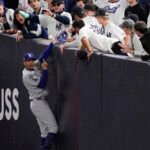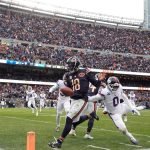Kevin Durant finished with 31 points in a win Saturday over Dallas, joining the 29,000 Points Club. Afterward, he was asked about the milestone and took a moment to reflect.
“It speaks to so many people that helped me out,” the Phoenix Suns forward said in the on-court interview. “So many people that got in the gym with me. Encouraged me. Send me texts after bad games. Took time out their life to come watch me play and be invested in my career. It’s all about them.”
But then he ended the thought with a familiar sentiment. He made a similar reference when he passed 25,000 points. He followed his monologue about the honor of the feat with a reminder of more feats to come. Because Durant, while possessing a deep respect for the history of the game, refuses to be regarded as some finished star collecting pats on the back in his final days. He doesn’t like the tone of those end-of-career reflection questions. The end ain’t near. So he punctuated his appreciation with a pledge.
“I’ve got more to do.”
And then he dropped 30 in a home win over the Los Angeles Lakers.
If Durant, who turned 36 in September, has a moderately good year by his standards, he’ll score upward of 1,500 points this season. Along the way, he’ll pass Moses Malone and Julius Erving and move into eighth place on the career scoring list that includes the ABA. He passed Shaquille O’Neal last year to reach the top 10. Anything over 2,000 points this season and KD would be stalking Wilt Chamberlain at No. 7.
The story of the greatest players in NBA history. In 100 riveting profiles, top basketball writers justify their selections and uncover the history of the NBA in the process.
The story of the greatest plays in NBA history.
Of the legends he could pass this season, Moses and Dr. J — even throw in Shaq and Wilt — guess who totaled the most points at age 36? O’Neal at 1,333, edging Malone’s 1,279. Erving and Chamberlain were in their final season at 36 and barely scored over a thousand points.
Meanwhile, saying Durant could average 25 points per game is a cold take, cooler than a polar bear’s toenails.
That’s why Durant is out here referencing legendary milestones as if he’s rounding third base. Like he merely earned a gold rank on Call of Duty. He knows he’s still among the best, and he’ll have more questions about more milestones and more legends he’ll overtake. So the 11th oldest player in the NBA, who is averaging 40 minutes per game so far, can look past 29,000 points as if it were a point guard defending him.
Yeah, this era of old heads is different.
Don’t get it twisted. The changing of the guard in the NBA is happening. Nikola Jokić already sparked the transition. Shai Gilgeous-Alexander. Luka Dončić. Anthony Edwards. Victor Wembanyama. The league will be theirs. Their names on the marquee. Their presence drawing the masses. Their legacies the subject of online battles.
It should already have happened, to be honest. If not for the Uncle Brigade. LeBron James. Stephen Curry. Kevin Durant. James Harden. Damian Lillard. Kawhi Leonard and Jimmy Butler, when healthy. The NBA has never seen this many OGs still cooking. Working the grill in sandals with socks on.
It’s a testament to the advances in kinesiology, technology and hoopology. More than anything, though, it’s an illustration of how much they love the game. Their dedication to the craft and competitive spirits. Magnificently maniacal, they are. Real hoopers.
Some of them have maintained impeccable shape and can run with this new breed of stars. Some of them mock modern training culture with old-school grit, needing just a couple of months to get in shape and a foam roller.
Just about all of them thrive on elite skill, the experience they garnered growing up in the league, watching and battling Kobe Bryant, and the heart they made it here with. They all share a toughness that defines their generation. They played outside. They drank water out of hoses and grubbed at the food court in the mall. They grew up playing hoop outside, under summer heat on concrete courts. Their ligaments and muscles have been fortified by night club calisthenics, THC and compression fabric.
The next generation will have to pry the superstar scepters from their social security grips.
LeBron turned 30 years old during the 2014-15 season. Before that season, the NBA had a player average 25 points or more 334 times over 68 seasons. Of those, 18 were accomplished by players aged 33 or older.
So 5.4 percent of the best scorers were in past-prime ages.
But since and including the season LeBron turned 30, a player has averaged at least 25 points per game 128 times over 10 seasons — 13 of them by players 33 and up. Up to 10.2 percent. Nearly double the rate.
Last year, eight players in their 30s averaged 23 or more. It was the second season in a row that happened, which broke the previous record of seven in 2020-21. Before that, the most was six players.
In 1995-96: Michael Jordan, Hakeem Olajuwon, Karl Malone, David Robinson, Charles Barkley and Mitch Richmond. The oldest was The Dream at 33.
In 1985-86: Adrian Dantley, Alex English, Moses Malone, Mike Mitchell, World B. Free and Kareem Abdul-Jabbar, who was the eldest at 38.
This season, some 10 to 12 players in this age demographic could average at least 20. In addition to the aforementioned: Paul George, DeMar DeRozan, Kyrie Irving, Klay Thompson, Nikola Vučević and CJ McCollum.
This league’s got more successful thirtysomethings than an overpriced Saturday brunch downtown.
Yes, some of their success is attributable to the era. The 3-pointer obsession, and the space it creates, makes averaging 20 points at least slightly easier. But anyone who watches the Uncle Brigade go to work and credit their greatness to this era is missing it.
Yes, they’re getting paid crazy figures. It’s easy to stick around when the standard midlevel exception is $12 million, which is more than what Barkley ever made in an NBA season. But these veterans who have lapped the field aren’t making the midlevel. They’re good enough to command the big salaries. And anyone who thinks it’s just about the money for them is missing it.
Watch them play. This is a different kind of hardcore, the kind not romanticized in the same way clotheslines were in the 1980s. The kind they were flamed for not having because of load management allegations and friendships.
But you know what’s tough. They’re still here. Still killing it. Still magnetic as ever. The Unexpendables.
Many of them don’t have a real shot at a championship. They’re just in it for the bag and the glory. Flexing their supremacy. Competing because they can.
Don’t miss what’s happening. Don’t take for granted how some of the best players we’ve ever seen have packed two lifetimes in their careers. The game has changed. The world has changed. Yet, their greatness, their showmanship, their presence have survived it all. They’ve been consistently excellent, reliably entertaining.
Eventually, they’ll get ushered off the main stage, if they don’t leave first. The rightful heirs will take over.
And we can only hope the new generation gives as much of themselves as the aging stars. That the future faces of the NBA learn a valuable lesson as they pry away the scepters: It takes greatness to get to the top, but staying there requires different. They’ve got more to do.
Sign up to get The Bounce, the essential NBA newsletter from Zach Harper and The Athletic staff, delivered free to your inbox.
(Illustration: Meech Robinson / The Athletic; photos: Barry Gossage / NBAE via Getty Images; Stacy Revere, Alika Jenner / Getty Images)











